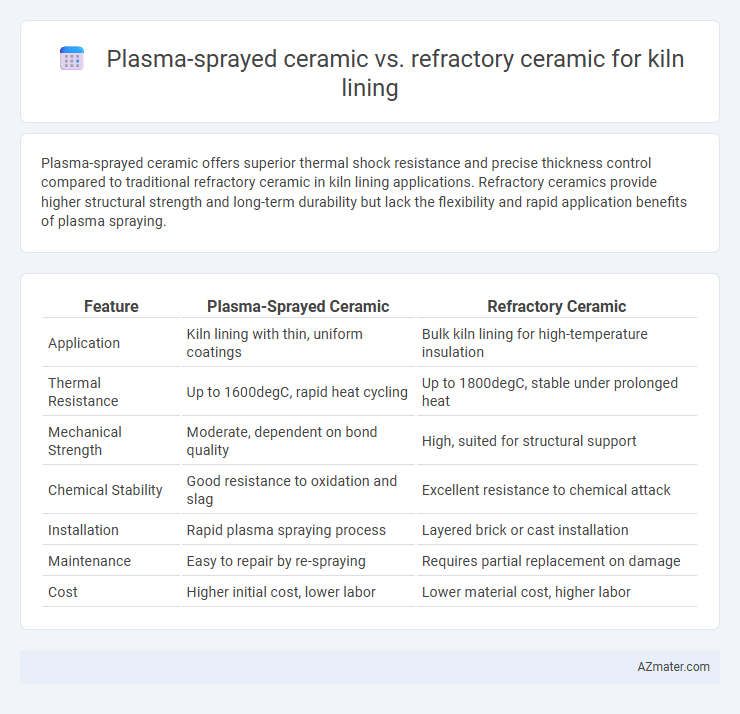Plasma-sprayed ceramic offers superior thermal shock resistance and precise thickness control compared to traditional refractory ceramic in kiln lining applications. Refractory ceramics provide higher structural strength and long-term durability but lack the flexibility and rapid application benefits of plasma spraying.
Table of Comparison
| Feature | Plasma-Sprayed Ceramic | Refractory Ceramic |
|---|---|---|
| Application | Kiln lining with thin, uniform coatings | Bulk kiln lining for high-temperature insulation |
| Thermal Resistance | Up to 1600degC, rapid heat cycling | Up to 1800degC, stable under prolonged heat |
| Mechanical Strength | Moderate, dependent on bond quality | High, suited for structural support |
| Chemical Stability | Good resistance to oxidation and slag | Excellent resistance to chemical attack |
| Installation | Rapid plasma spraying process | Layered brick or cast installation |
| Maintenance | Easy to repair by re-spraying | Requires partial replacement on damage |
| Cost | Higher initial cost, lower labor | Lower material cost, higher labor |
Introduction to Kiln Lining Technologies
Plasma-sprayed ceramic coatings offer advanced thermal barrier properties and rapid installation for kiln linings, enhancing heat resistance and extending service life in high-temperature environments. Refractory ceramics, traditionally used for kiln linings, provide robust chemical stability and mechanical strength under prolonged thermal cycling. Selecting between plasma-sprayed and refractory ceramics depends on factors like operating temperature, thermal shock resistance, and maintenance requirements to optimize kiln performance.
Overview of Plasma-Sprayed Ceramic Coatings
Plasma-sprayed ceramic coatings offer superior thermal barrier properties and erosion resistance compared to traditional refractory ceramics used in kiln linings. The coating process involves heating ceramic powders to a molten state and propelling them onto the substrate, forming a dense, adherent layer that enhances kiln longevity and energy efficiency. These coatings provide fine microstructure control, enabling tailored thermal conductivity and resistance to thermal shock, making them ideal for high-temperature kiln environments.
Characteristics of Refractory Ceramic Materials
Refractory ceramic materials used in kiln linings exhibit high thermal stability, excellent resistance to thermal shock, and superior mechanical strength at elevated temperatures, ensuring durability and prolonged service life. They typically possess low thermal conductivity, which minimizes heat loss and improves energy efficiency during kiln operation. Plasma-sprayed ceramics may offer a more uniform coating but generally lack the bulk thermal mass and robust structural integrity found in traditional refractory ceramic bricks.
Thermal Performance Comparison
Plasma-sprayed ceramic coatings exhibit superior thermal insulation properties with lower thermal conductivity compared to refractory ceramics, enabling faster heat-up and improved energy efficiency in kiln linings. Refractory ceramics, while offering high temperature resistance and structural stability, generally possess higher thermal mass leading to slower thermal response. The enhanced thermal barrier of plasma-sprayed ceramics reduces heat loss and prolongs kiln component lifespan by minimizing thermal stress and deformation.
Resistance to Chemical Attack
Plasma-sprayed ceramic coatings exhibit superior resistance to chemical attack due to their dense microstructure and strong adhesion, effectively protecting kiln linings against aggressive slags and corrosive gases. Refractory ceramics, while highly durable at elevated temperatures, are more prone to chemical degradation and erosion when exposed to acidic or basic environments prevalent in many kiln operations. Optimizing kiln lining performance involves selecting plasma-sprayed ceramics for enhanced chemical inertness and longer service life under harsh chemical conditions.
Mechanical Durability and Wear Resistance
Plasma-sprayed ceramic coatings offer superior wear resistance due to their dense microstructure and strong adhesion, making them highly effective in protecting kiln linings from abrasive and corrosive wear. Refractory ceramics excel in mechanical durability with excellent thermal shock resistance and structural integrity under high-temperature cycling, but often exhibit lower surface hardness compared to plasma-sprayed coatings. The combination of plasma-sprayed ceramics for wear-critical surfaces and refractory ceramics for bulk insulation enhances overall kiln lining performance by maximizing both mechanical durability and abrasion resistance.
Installation Methods and Application Efficiency
Plasma-sprayed ceramic kiln linings offer rapid installation through thermal spraying, creating a dense, bond-enhanced coating that reduces downtime and improves heat transfer efficiency. Refractory ceramic linings require traditional casting or bricklaying methods, involving longer installation times but providing superior mechanical strength and resistance to thermal shock. Plasma spraying is ideal for refurbishments and thin coatings, while refractory ceramic excels in high-stress environments demanding thick, durable linings.
Maintenance Requirements and Lifespan
Plasma-sprayed ceramic coatings offer enhanced wear resistance and reduced maintenance intervals compared to traditional refractory ceramics used in kiln linings, due to their dense microstructure and strong adhesion properties. Refractory ceramics typically require more frequent inspections and repairs because of their susceptibility to thermal shock and mechanical spalling under high-temperature cycling. Plasma-sprayed ceramics generally extend kiln lining lifespan by 20-30%, minimizing downtime and improving overall operational efficiency in industrial furnace applications.
Cost Analysis and Economic Considerations
Plasma-sprayed ceramic coatings typically present higher upfront costs due to advanced equipment and skilled labor requirements, but they offer longer service life and reduced maintenance expenses, leading to lower total cost of ownership in high-temperature kiln applications. Refractory ceramics, while generally less expensive initially, may incur higher replacement and downtime costs due to their susceptibility to thermal cycling damage and slower installation processes. Economic considerations favor plasma-sprayed ceramics in industrial settings prioritizing operational efficiency and lifespan, whereas refractory ceramics remain cost-effective for short-term or low-intensity kiln operations.
Suitability for Various Kiln Types and Industrial Uses
Plasma-sprayed ceramic linings offer superior thermal shock resistance and rapid installation, making them ideal for rotary and tunnel kilns used in fast-paced industrial environments like cement and steel manufacturing. Refractory ceramic linings provide exceptional high-temperature stability and chemical inertness, making them suitable for shaft kilns and glass furnaces where prolonged exposure to extreme heat and corrosive atmospheres occurs. Selection depends on kiln operation conditions, with plasma-sprayed ceramics favored for abrasion resistance and quick turnaround, while refractory ceramics excel in longevity and structural integrity under sustained high temperatures.

Infographic: Plasma-sprayed ceramic vs Refractory ceramic for Kiln lining
 azmater.com
azmater.com